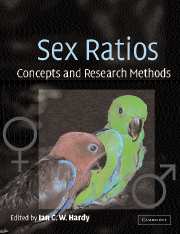Book contents
- Frontmatter
- Contents
- List of contributors
- Preface and acknowledgements
- Part 1 Sex ratio theory
- Part 2 Statistical analysis of sex ratio data
- Chapter 3 Statistical analysis of sex ratios: an introduction
- Chapter 4 Analysis of sex ratios in social insects
- Chapter 5 Analysis of sex ratio variances and sequences of sex allocation
- Chapter 6 Comparative analysis of sex ratios
- Part 3 Genetics of sex ratio and sex determination
- Part 4 Animal sex ratios under different life-histories
- Part 5 Sex ratios in plants and protozoa
- Part 6 Applications of sex ratios
- Index
- References
Chapter 4 - Analysis of sex ratios in social insects
Published online by Cambridge University Press: 06 August 2009
- Frontmatter
- Contents
- List of contributors
- Preface and acknowledgements
- Part 1 Sex ratio theory
- Part 2 Statistical analysis of sex ratio data
- Chapter 3 Statistical analysis of sex ratios: an introduction
- Chapter 4 Analysis of sex ratios in social insects
- Chapter 5 Analysis of sex ratio variances and sequences of sex allocation
- Chapter 6 Comparative analysis of sex ratios
- Part 3 Genetics of sex ratio and sex determination
- Part 4 Animal sex ratios under different life-histories
- Part 5 Sex ratios in plants and protozoa
- Part 6 Applications of sex ratios
- Index
- References
Summary
Summary
Studies of social insects' sex ratios have so far only used statistics analysing (arcsine-transformed) proportions or (log-transformed) ratios. This approach is inaccurate when clutch sizes are highly variable and residuals are overdispersed, as is the case when sex ratios are split. Here we outline a protocol based on logistic regression that simultaneously tests for:
Deviations of the total (population-wide) sex ratio from a theoretically predicted equilibrium value (e.g. 1:1 or 3:1).
Direct or partial correlations of colony-level sex ratio with discrete or continuous predictor variables or co-variables.
The degree of over- or underdispersion of the variance in colony sex ratios compared to a binomial null model, both before analysis and after the inclusion of significant predictor variables.
The tests explicitly take variation in clutch size into account. We use a previously published dataset on sex allocation in the ant Lasius niger as a worked example, using SAS as the statistical software tool, and evaluate the validity of previous statistical analyses on proportional sex ratio data with the outcome of our current analyses. The present protocol allows evolutionary hypotheses on sex allocation to be tested in the absence of accurate estimates of the female-to-male cost ratio, provided the sample size is large enough.
Introduction
Formal analysis of sex ratios in social insects started with the seminal paper by Trivers and Hare (1976).
- Type
- Chapter
- Information
- Sex RatiosConcepts and Research Methods, pp. 93 - 111Publisher: Cambridge University PressPrint publication year: 2002
References
- 22
- Cited by



